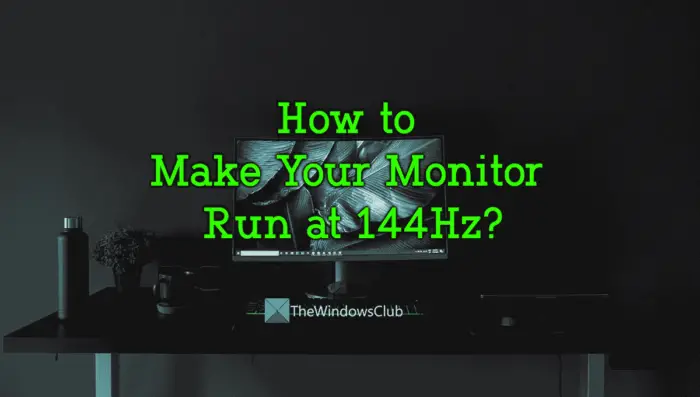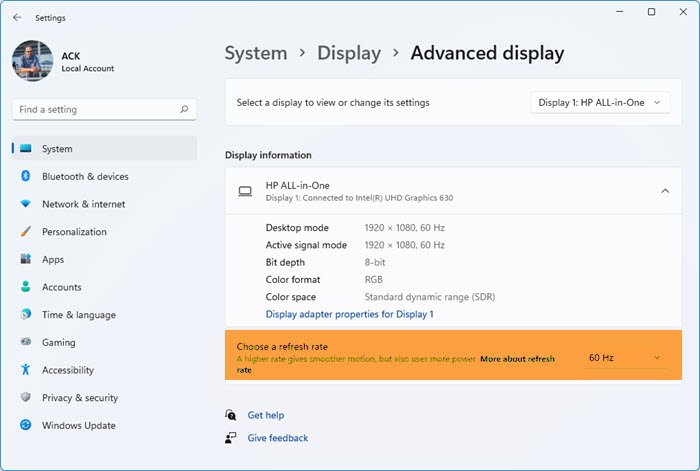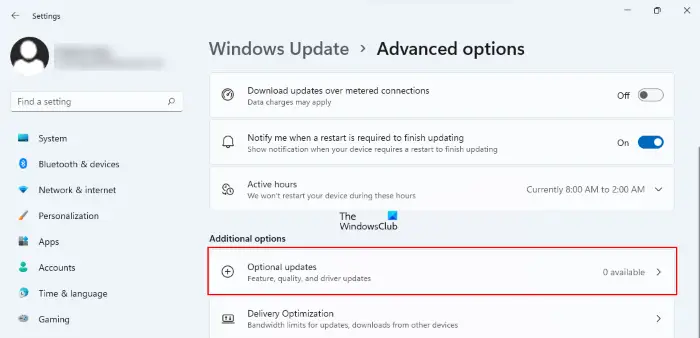We see monitors of 60Hz, 120Hz, 144Hz, or even higher. Have you ever wondered what they are and how does it impact the display? Each monitor has a Refresh rate, that is, the number of times a display can be able to draw a new image per second. It is measured in Hertz (Hz). That means, if you buy a monitor with a 144Hz refresh rate, the display refreshes 144 times per second to show you a visual. Just having a monitor with a higher refresh rate does not guarantee, it gives a smoother experience. It also needs a capable GPU and CPU that work together with the display to produce outstanding images in the range of 144hz. In this guide, we show you how to make your monitor run at 144Hz.
How to make your Monitor run at 144Hz?

If you have a 144Hz monitor and see it run on a low refresh rate, you can implement the following fixes to run it at 144Hz.
- Set Refresh Rate to 144Hz
- Check your cables
- Make sure your GPU supports a 144Hz refresh rate
- Update graphics drivers
- Set In-game settings to use 144Hz
Let’s get into the details of each fix.
1] Set Refresh Rate to 144Hz

You need to set the refresh rate on your PC to 144Hz. It might have been set to lower rates. If you set it to 144Hz, your monitor will run at 144Hz and give you the best images.
To set the Refresh rate in Windows 11,
- Press Win+I to open the Settings app
- Click on System
- Select the Display tab and then Advanced Display
- Next, find Choose a refresh rate setting in the Advanced display page and select 144Hz from the drop-down menu.
It will make your monitor run at 144Hz.
2] Check your cables
Though you have the best display with a 144Hz refresh rate, the cables can play the spoilsport. You need to make sure the cable is not faulty. Also, you need to select HDMI 2.0 or Display Port 1.4 to be able to run the 144Hz with higher resolutions. Mostly, the cables that come with the monitor do the work. Check the ports your cables are plugged into and make changes so that they support 144Hz at higher resolutions.
3] Make sure your GPU supports a 144Hz refresh rate
If you have a 144hz refresh rate monitor with a very basic GPU or no dedicated Graphics card on your PC, the monitor does not work at 144Hz. You need to have GPU that has the capabilities to run a 144Hz monitor. Without that, it won’t work. While buying a GPU, you will see the details of the resolutions and refresh rates it support.
4] Update graphics drivers
You need to have the latest graphics drivers to run a 144Hz refresh rate without any issues. You need to update the graphics drivers to the latest version.
You can use one of the methods below to update your device drivers:
- Check for Driver Updates via Windows Update to update your drivers
- Visit the manufacturer’s site to download the drivers.
- Use a free driver update software
5] Set In-game settings to use 144Hz
Each game has settings that you can tweak to decide how the game should look. You need to go into the settings of the games you are playing and set the display refresh rate to 144Hz. It will make sure the monitor runs at 144Hz while playing those games.
This is how you can make your monitor run at 144Hz.
Read: Enable Variable Refresh Rate for games in Windows 11/10
How do I set my monitor to 144Hz?
You can set your monitor to 144hz in the Display settings of Windows, or in programs like NVIDIA control panel, AMD Radeon Software, etc. It is not guaranteed that your monitor will run at 144Hz if you set it through settings. Your PC should have the capability to run 144Hz at higher resolutions.
Why is my 144Hz monitor capped at 60Hz?
Your 144Hz refresh rate supported monitor might be capped at 60Hz due to many reasons, the PC configuration does not have the power to run a 144Hz monitor, the GPU does not support 144Hz, the cables do not support it, etc.
Related read: 144Hz option not showing up in Display options of Windows 11/10.
Leave a Reply